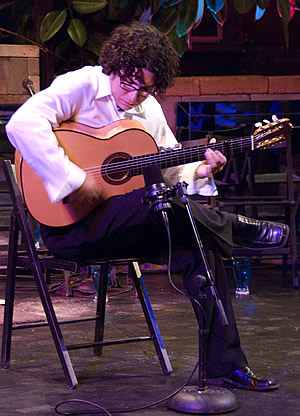Flamenco: Music That Makes You Cry
by Phil Houseal
July 21, 2010
Most American teenage guitar players want to grow up to be rock stars. Randy Cordero wanted to play flamenco.
The infatuation with this romantic art began for the Corpus Christi native while he lived in Colorado.
“While I was there I heard a flamenco group,” he said. “I was mesmerized, and real curious how to play that style of music. I wanted to learn to play flamenco.”
He finally got the chance around 1995 when he joined a group at Texas A&M that played lots of medieval music and music from Spain.
“We wore medieval costumes – like troubadours with ruffles and capes, the whole attire. We played different instruments such as the Spanish lutes and mandolins. That’s how I got exposed to folk music from Mexico, Argentina, and Spain. I was captured by it and wanted to know how to play it.”
He sought out and studied with some of America’s top flamenco guitar players, and continues to learn and spread knowledge about the genre. According to Cordero, there are three key elements that make flamenco “flamenco” – singing, dancing, and guitar playing. Those combine to make an authentic flamenco show.
What distinguishes flamenco guitar playing is the right hand strumming, with its many variations in rhythm, speed, and dynamics; the unusual minor tonal scales (“very tragic, very emotional”); and the mixture of cultural influence, including Arabic, Celt, Spanish, and Mediterranean.
But the secret – and the challenge – is putting all those elements together as you perform.
“When you play a real show you have a singer and a dancer,” Cordero noted. “The guitarist always has to go up and down with their speed, with one ear on the dancer, and one on the singer. You are never sure where they will go.”
The distinct rhythms that make flamenco so appealing also make it foreign to many western ears. Cordero encounters a “kind of mixed reaction” when he launches into a complex flamenco tune with its 12/8 rhythms.
“Many will say that’s beautiful music, but American ears are just not accustomed to the unexpected rhythms. When I play a 4/4 count rumba, people applaud like crazy. But when I playa true flamenco piece in 12/8 count, American ears are just not accustomed to the rhythmic accents.”
Some evenings he encounters confusion before he plays a note.
“Some people think I’m mariachi that walks around. But I have to be seated, as it is very intricate playing. That’s why I try to educate people and will lecture and demonstrate as I play.”
Cordero is proud that he performs authentic flamenco music, sounds “that you would hear walking down the street in Spain.”
Like early American blues and jazz, flamenco traces its roots to the black slaves from Africa. In Spain, gypsies who practiced it were outcasts and looked down on. But they poured all their poverty and sorrows into the music.
Ultimately, that emotion and passion is what defines true flamenco. Aficionados even have a word for it: Duende.
“It is kind of hard to interpret,” Cordero said. “It is almost as some deep emotional spirit that gets into the dancer or singer or player. It is transcendental – pure energy that comes out through the art form. It is very spontaneous.”
“You can have a good guitar player who plays note for note, but with no feeling. Then there are some guitarists who can make you cry.”

